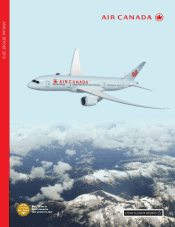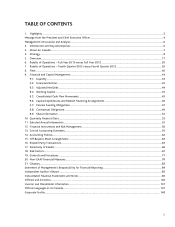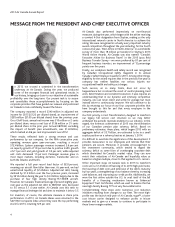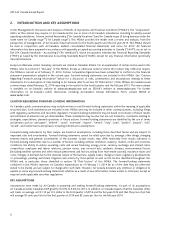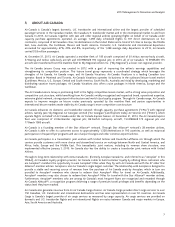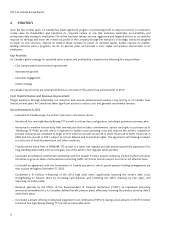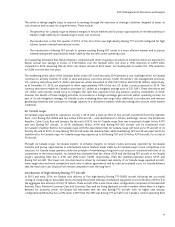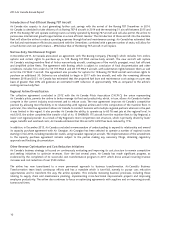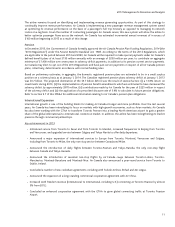Air Canada 2013 Annual Report Download - page 2
Download and view the complete annual report
Please find page 2 of the 2013 Air Canada annual report below. You can navigate through the pages in the report by either clicking on the pages listed below, or by using the keyword search tool below to find specific information within the annual report.
1. HIGHLIGHTS
The financial and operating highlights for Air Canada for the periods indicated are as follows.
(Canadian dollars in millions, except where indicated)
Fourth Quarter Full Year
2013 2012 $ Change 2013 2012 $ Change
Financial Performance Metrics
Operating revenues 2,894 2,839 55 12,382 12,114 268
Operating income 135 47 88 619 442 177
Non-operating expense (1) (141) (107) (34) (617) (522) (95)
Income (loss) before income taxes and discontinued operations (6) (60) 54 2 (80) 82
Net income (loss) from continuing operations (6) (60) 54 10 (81) 91
Net loss from discontinued operations – Aveos - - - - (55) 55
Net income (loss) (6) (60) 54 10 (136) 146
Adjusted net income (loss) (2) 3 (5) 8 340 55 285
Operating margin, excluding the impact of benefit plan
amendments % (3)
1.8% 1.7% 0.1 pp 4.3% 2.6% 1.7 pp
Operating margin % 4.7% 1.7% 3.0 pp 5.0% 3.6% 1.4 pp
EBITDAR, excluding the impact of benefit plan amendments (3) (4)
277 283 (6) 1,433 1,320 113
EBITDAR (4) 359 283 76 1,515 1,447 68
EBITDAR margin, excluding the impact of benefit plan
amendments % (3) (4) 9.6% 10.0% (0.4) pp 11.6% 10.9% 0.7 pp
EBITDAR margin % (4) 12.4% 10.0% 2.4 pp 12.2% 11.9% 0.3 pp
Unrestricted liquidity (5) 2,364 2,018 346 2,364 2,018 346
Free cash flow (6) (276) (21) (255) (231) 199 (430)
Adjusted net debt (7) 4,351 4,137 214 4,351 4,137 214
Return on invested capital ("ROIC") %(8) 11.0% 7.9% 3.1 pp 11.0% 7.9% 3.1 pp
Diluted earnings (loss) per share ($0.02) ($0.22) $0.20 $0.02 ($0.51) $0.53
Adjusted net income (loss) per share – diluted (2) $0.01 ($0.02) $0.03 $1.20 $0.20 $1.00
Operating Statistics (9) % Change % Change
Revenue passenger miles (millions) ("RPM") 12,882 12,574 2.5 56,788 55,646 2.1
Available seat miles (millions) ("ASM") 16,033 15,484 3.5 68,573 67,269 1.9
Passenger load factor % 80.3% 81.2% (0.9) pp 82.8% 82.7% 0.1 pp
Passenger revenue per RPM (“Yield”) (cents) 19.6 19.7 (0.6) 19.1 19.0 0.5
Passenger revenue per ASM (“RASM”) (cents) 15.7 16.0 (1.7) 15.9 15.8 0.6
Operating revenue per ASM (cents) 18.1 18.3 (1.6) 18.1 18.0 0.3
Operating expense per ASM (“CASM”)
excluding the impact of benefit plan amendments (cents) (3) 17.7 18.0 (1.8) 17.3 17.5 (1.5)
Adjusted CASM (cents) (10) 12.1 12.4 (2.3) 11.6 11.8 (1.5)
Average number of full-time equivalent ("FTE") employees
(thousands) (11) 24.1 24.1 0.2 24.5 24.0 2.0
Aircraft in operating fleet at period end 352 351 0.3 352 351 0.3
Average fleet utilization (hours per day) 9.4 9.4 (0.2) 10.0 10.0 0.2
Aircraft frequencies (thousands) 131 134 (1.8) 548 557 (1.7)
Average aircraft flight length (miles) 807 798 1.1 837 828 1.1
Economic fuel cost per litre (cents) (12) 88.4 88.2 0.3 89.0 89.6 (0.6)
Fuel litres (millions) 943 941 0.2 3,993 4,021 (0.7)
Revenue passengers carried (millions) (13) 8.5 8.3 3.0 35.8 34.9 2.3
(1) In 2013, Air Canada recorded an interest charge of $95 million related to the purchase of its senior secured notes which were to become due in 2015 and 2016.
(2) Adjusted net income (loss) and adjusted net income (loss) per share – diluted are non-GAAP financial measures. Refer to section 20 “Non-GAAP Financial Measures” of the MD&A for additional information.
(3) In the fourth quarter of 2013, Air Canada recorded an operating expense reduction of $82 million related to amendments to defined benefit pension plans. In the third quarter of 2012, Air Canada recorded an
operating expense reduction of $127 million related to changes to the terms of the ACPA collective agreement pertaining to retirement age. Refer to section 20 “Non-GAAP Financial Measures” of the MD&A
for additional information.
(4) EBITDAR (earnings before interest, taxes, depreciation, amortization, impairment and aircraft rent) is a non-GAAP financial measure. Refer to section 20 "Non-GAAP Financial Measures" of the MD&A for
additional information.
(5) Unrestricted liquidity refers to the sum of cash, cash equivalents, short-term investments and the amount of available credit under Air Canada’s revolving credit facilities. At December 31, 2013, unrestricted
liquidity was comprised of cash and short-term investments of $2,208 million and undrawn lines of credit of $156 million. At December 31, 2012, unrestricted liquidity was comprised of cash and short-term
investments of $1,973 million and undrawn lines of credit of $45 million.
(6) Free cash flow (cash flows from operating activities less additions to property, equipment and intangible assets) is a non-GAAP financial measure. Refer to section 9.5 of the MD&A for additional information.
(7) Adjusted net debt (total debt less cash, cash equivalents and short-term investments plus capitalized operating leases) is a non-GAAP financial measure. Refer to section 9.3 of the MD&A for additional
information.
(8) Return on invested capital (ROIC) is a non-GAAP financial measure. Refer to section 20 of the MD&A for additional information
(9) Operating statistics (except for average number of FTE employees) include third party carriers (such as Jazz Aviation LP (“Jazz”)) operating under capacity purchase agreements with Air Canada.
(10) Adjusted CASM is a non-GAAP financial measure. Refer to section 20 “Non-GAAP Financial Measures” of the MD&A for additional information.
(11) Reflects FTE employees at Air Canada. Excludes FTE employees at third party carriers (such as Jazz) operating under capacity purchase agreements with Air Canada.
(12) Includes fuel handling expenses. Economic fuel price per litre is a non-GAAP financial measure. Refer to sections 6 and 7 of the MD&A for additional information.
(13) Revenue passengers are counted on a flight number basis which is consistent with the IATA definition of revenue passengers carried.

